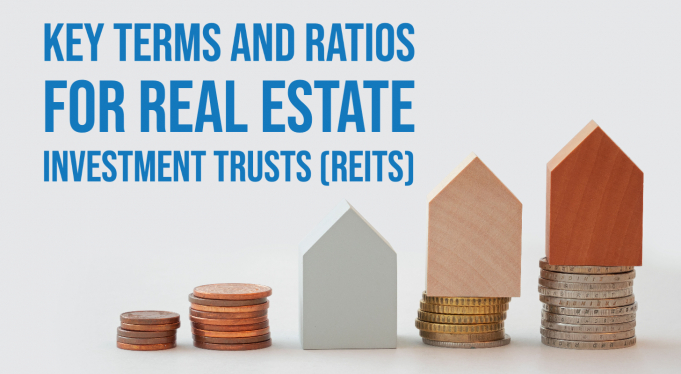What is a Real Estate Investment Trust (REIT)?
A REIT is defined as a company that owns, operates, or finances income-generating real estate. REITs trade like stocks on major exchanges and offer investors a way to gain exposure to the real estate sector with much lower capital requirements than traditional forms of real estate investing and a steady income stream. A REIT company purchases income-producing properties, leases them, collects rents on the properties, and then redistributes that income to shareholders. REITs usually purchase properties with debt, earn cash flows to service that debt, and over time use the equity in those properties to increase their financial leverage and acquire more properties.
There are many different types of REITs that exist, and many specialize in various industries, such as the apartment building, cell tower, data center, hotels, healthcare, offices, retail centers, and warehouses industries. REITs are great for real estate exposure and stable cash flows, but they are also usually associated with low growth and are subject to interest rate and market risks.
In this blog, we will cover some of the main key ratios and metrics that we find particularly useful when evaluating REITs. This list is not exhaustive of all ratios applicable to REITs but includes some of the most popular ratios.
Key Metrics and Ratios When Analyzing REITs
1. REIT-Specific Metrics
Net Operating Income (NOI)
NOI is frequently used when analyzing REITs as it is a good proxy for a REITs operating income and cash flows. It is used to measure a REITs profitability before adding in costs from financing or taxes. It is a good metric to understand whether rent collected from the properties are sufficient enough to cover the costs of owning and maintaining them. Thus, an NOI of greater than zero is preferred. NOI is useful in calculating the Debt Service Coverage Ratio (DSCR), which we outline below.
The calculation for NOI is as follows:
Funds From Operations (FFO) and Adjusted Funds from Operations (AFFO)
FFO is used to assess the cash flows and profitability of a REIT. FFO can be a proxy for Earnings per Share (EPS) and differs from NOI in that it considers operational expenses, taxes, and interest expenses. FFO looks at the operating performance of a REIT company and focuses on the income from operating rental properties. Analysts also like to use Adjusted Funds From Operations (AFFO) to determine a more accurate picture of a REITs operating performance. AFFO subtracts additional recurring expenses that are amortized, and thus provides a better representation of cash flow. These metrics can typically be found in the notes section on a REITs financial statement.
2. Leverage Ratios
Debt-to-Equity (D/E)
REITs use debt to finance their income-generating properties, and as such evaluating their D/E ratio is important is determining if they are overleveraged or not. Their high debt loads means that they are sensitive to changes in interest rates, and thus looking at whether a company’s debt burden is greater than their equity position is important.
The D/E ratio is calculated as follows:
Typically, a D/E ratio of less than 1.0X is preferred (debts are lower than total equity), but the average real estate D/E ratio is roughly 3.5X. This gives a lot of leeway, but we prefer REITs that have as low D/E ratios as possible.
3. Liquidity Ratios
Debt Service Coverage Ratio (DSCR)
DSCR measures a REITs ability to service its current (one-year) debt obligations. It is a ratio that takes a REITs annual cash flows to assess if it can meet its one-year principal and interest payments. This is especially important for REITs as they carry a high debt load, and generating enough cash flows to service its debt is vital in staying solvent. A DSCR of more than 1.25X is preferred.
The DSCR formula is below:
The annual interest expense amount can be found on a company’s income statement, and the current portion of long-term debt can be found in the current liabilities section of a REITs balance sheet.
AFFO Payout Ratio
REITs are well-known for their above-average distribution yields provided to shareholders for being part owners of the several income-producing properties that a REIT holds. The sustainability of a distribution is traditionally known as the ‘payout ratio’ for non-REIT companies, and is calculated as the annual dividend divided by EPS. Although, a REITs EPS can be negatively impacted by its high depreciation expenses since its assets are predominately real estate. Thus, the AFFO payout ratio is the best measure of defining whether a REITs distribution is sustainable. An AFFO Payout Ratio of less than 1.0X is ideal, as it implies that the company is distributing not more than it generates in annual cash flows.
The calculation for AFFO payout ratio is below:
Conclusion
REITs offer investors a great method of gaining exposure to the real estate sector while also benefiting from capital appreciation of property values and stable cash flows. The business activities and operations of a REIT differ from that of traditional stocks, and as a result, it is important to know which metrics and ratios to use when evaluating these companies. REITs are debt-heavy companies, and because of this it is essential to look at a REITs liquidity (are its debt levels too high? Is it able to generate enough cash flow to service debt payments?) and whether its distributions exceed that of annual cash flows (is AFFO payout ratio above 1.0X?). We hope that this introduction to analyzing REITs has been helpful.
Research for Today, Invest for Tomorrow.

Twitter: @5iChris






Comments
Login to post a comment.